
Bullet and Splinter Wound Care Page Menu: 1 2 3 4 5 6 7 8 9 10 Next>>
Bullet and Splinter Wound Care in the Golden Age of Piracy, Page 3
Foreign Object Extraction Tools
“For the effecting of which [the removal of a bullet from a wound], our Masters have left us variety of Instruments". (Richard Wiseman, Several Chirurgicall Treatises, 1686, p. 341)
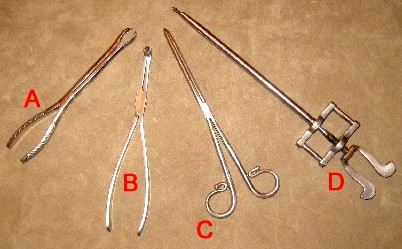
The Author's Bullet Extraction Tools: A - Bullet Extractor Forceps,
B - Crow's Bill Forceps, C - Regular Forceps, D - Bullet Extractor
Screw/Terebellum
As Wiseman suggests, surgeons began developing specific tools for removing bullets, due in large part to the depths which bullets could reach in the body and the narrowness of the wound they produced. Modern historian Elizabeth Bennion says that the first such instruments began to appear in the early 16th century, beginning with the terebellum which appeared in 1535.1 Around the same time, bullet forceps with curved, serrated ends to better grasp the bullet appeared.2
A variety of other tools were designed in the 16th century for searching for and removing objects from wounds, many of which were still in use during the golden age of piracy. Among those mentioned in the texts under study were probes and needles, speculums, fingers, forceps, the terebellum and other mechanical extraction devices. Let's look at them.
1 Elizabeth Bennion, Antique Medical Instruments, 1979, p. 156; 2 Bennion, p. 157
Foreign Object Extraction Tools - Probes and Needles
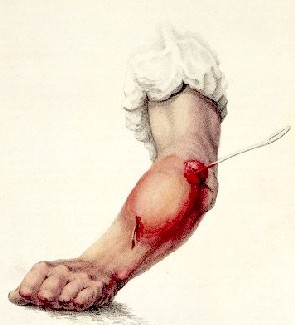
Probing a Forearm Wound With a Seton Needle, From
The Principles of Surgery in Two Volumes, By John Bell
Several of the surgical manuals from this period mention the act of probing a wound. Elizabeth Bennion says that a variety of extant probes, usually made from silver, have been found which precede the golden age of piracy, so we know such tools were available at this time. She further notes that probing was necessary because there was no other reasonable way to search for embedded objects in a wound.1 (The x-ray machine was still hundreds of years in the future.)
For searching out bullets, Richard Wiseman suggested that surgeons use either their finger or a probe, not indicating a preference for one over the other.2 Sea surgeon John Moyle recommended that when dealing with deep gunshot wounds, the surgeon would need a long probe.3 Like Moyle, Ambroise Paré particularly recommends probes for deep wounds, where the fingers would usually be too short or wide to get at the bullet. He explains that in such cases, "you shall search for it with a round and blunt probe, lest you put the Patient to pain; yet oftentimes you shall scarce by this means find the Bullet."4
Paré has the most to say about the design of probes used in gunshot wounds.
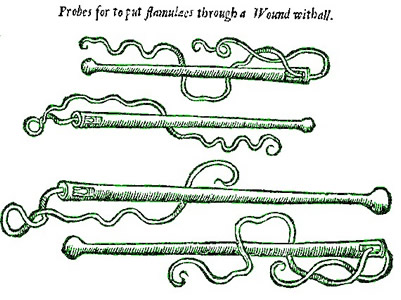
From The Workes of that Famous Chirurgion Ambrose Parey (1649)
He particularly suggests using seton needles as probes
to search, or as it were to sound the deepness of the Wounds, and to find out the Bullets. For they cannot put one to much pain because they have smooth and round ends. So also all Probes wherewith we search for Bullets, must have somewhat large, smooth and round ends. For seeing that the verges of the Wound meet together presently after the hurt, if the [ends of the] Probes be too smal or slender, they wil stick in the inequality of the flesh, neither will they be able to come to the Bullet. But if they be sharp and pointed, they will cause and renew the pain by pricking the flesh they meet withall, & so hinder your intention of finding the Bullet; Now you must be furnished with these instruments of a different length, according to the various thicknesse of the parts; for you cannot put any through the thigh but such as are of good length.5
Paré's use of the word 'sound' to locate the bullet is interesting, possibly suggesting the sound of the ball at the end of a metal probe against the metal of the bullet would identify it's location.
1 Elizabeth Bennion, Antique Medical Instruments, 1979, p. 73; 2 Richard Wiseman, Several Chirurgicall Treatises, 1686, p. 411; 3 John Moyle, The Sea Chirurgeon, 1693, p. 73; 4 Ambroise Paré, The Workes of that Famous Chirurgion Ambrose Parey, 1649, p. 316; 5 Paré, p. 317-8
Foreign Object Extraction Tools - Dilators
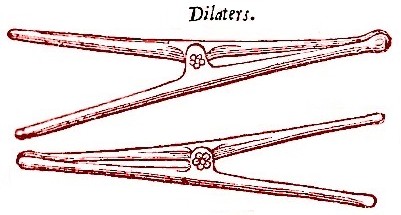
From The Workes of that Famous Chirurgion Ambrose Parey (1649)
Dilators are devices used to hold an orifice such as a bullet wound open so that its depths could be more easily plumbed. Only one author under study discusses them in reference to gunshot wounds and he almost seems to mention them in this capacity as an afterthought.
Ambroise Paré says "there are also other instruments fit to dilate and open the Wounds, [which are] therefore called Dilaters, by whose help the
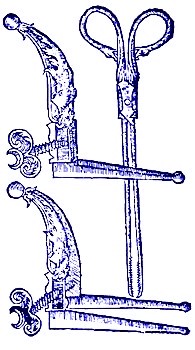
Swan's Bill with Crane's Bill
Forceps, Ambroise Paré (1649)
Wound may be held open, that so the hidden bodies may be seen"1. The ones he was talking about were manually operated, as seen in the image at left.
Although the workings seem fairly intuitive, Paré explained their use: "when you press together the two ends of this Instrument, the other two open and dilate themselves. You may also use them in dilating divers other parts of the body, as the Nostrils, Fundament, and such like."2
Paré identifies another sort of device which is more like a modern speculum, which he calls a Swan's Bill. He explains that the Swan's bill "opens with a screw; you may with this dilate the Wounds, and so put in a straight Cranes-bill [forceps], as pincers to pluck forth strange bodies."3

Non-Bullet Wound Speculums, From The Chyrurgeons Storehouse,
By Johannes Scultetus, p. 43 (1674)
Presumably longer and more slender forceps like the crow's bill forceps shown in the swan's bill image could also be inserted into the wound while the surgeon's assistant, or mate, used dilators to hold the wound open. It would have been much easier with the screw, however, since the surgeon would otherwise be relying upon the grip strength of his mate.
The previous text makes it sound as if a speculum is a modern device. In fact, the word 'speculum' in reference to a device to hold orifices open is not at all modern, dating to the late 16th century when Paré was writing. German physician Johannes Scultetus actually has a drawing of a device remarkably like a modern speculum, although he does not reference it in connection with opening gunshot wounds.
1,2.3 Ambroise Paré, The Workes of that Famous Chirurgion Ambrose Parey, 1649, p. 317
Foreign Object Extraction Tools - Fingers
The most basic tool used to remove objects from wounds were fingers. Germ theory was well over a century in the future so surgeons had no qualms about using the human forceps to remove objects from wounds. Writing as late as 1808, surgeon Edward Cutbush said, "But if the ball or any foreign matter be near the surface, it ought to be cut upon and removed. The index finger is the best probe."1
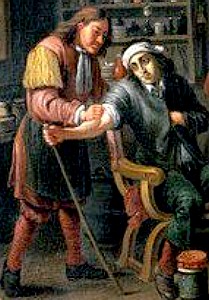
Artist: David Teniers II
Using Fingers to Probe a Wound (1679)
Several surgeons from around the golden age of piracy refer to the use of this most basic tool to extract foreign objects. When searching for the bullet in a gunshot wound, Richard Wiseman advises his readers to "make search for them with your Finger or Probe."2 In one of his case studies of a gunshot wound with a fracture, Wiseman explains, "Then putting my Fingers into his Wound, I pulled out first a piece of Splinter an inch thick and thereabouts, more or less; then Rag and Bones, great and small; I left not the least Shiver [fragment of bone]."3
French surgeon Ambroise Paré mentions using his fingers several times when searching for foreign objects in wounds. When discussing bullet wounds, he recommends to his reader that "if it be possible, search for these [foreign] bodies [in the wound] with your finger, that so you may the more certainly and exactly perceive them."4 The sensitivity of fingers provided an easy way to diagnose a problem. Paré used this method himself, explaining in one of his case studies that "I put my finger into him; where I found the entrance of the Bullet to have broken the fourth Rib in the middle and scales [shards] of bones which the said Bullet had thrust in"5. He also used his fingers to search for a bullet that couldn't be found by looking into the wound "by gently pressing with my fingers, the parts near the Wound, and the rest which I suspected... You shall observe this, and rather believe the judgment of your fingers, than of your Probe."6
Sea surgeon John Atkins also advises the use of fingers: "Flesh Wounds, especially by Great Guns or Splinters, are commonly large enough to discover any extraneous Body, to be extracted presently with your Fingers or Forceps"7.
1 Edward Cutbush, Observations on the Means of Preserving the Health of Soldiers and Sailors, 1808, p. 232; 2 Richard Wiseman, Several Chirurgicall Treatises, 1686, p. 411; 3 Wiseman, p. 426; 4 Ambroise Paré, The Workes of that Famous Chirurgion Ambrose Parey, 1649, p.316; 5 Paré, p. 777; 6 Paré, p. 316; 7 John Atkins, The Navy Surgeon, 1742, p. 148
Foreign Object Extraction Tools - Bullet Scoops and Hooks
Only one of the period surgeons, Johannes Scultetus, specifically mentions bullet scoops and hooks, but they are so simple and similar to other tools a surgeon would have had in his arsenal of instruments that they were likely made use of when it made sense. Modern historian Elizabeth Bennion says that bullet scoops "date from the seventeenth century at least... [such a device] was used here [England], practically unchanged, through the eighteenth century."1
Scultetus has little to say about these devices (seen below). Of the top device, he notes it "is a little iron hook which serveth to bring forth bullets."2 Of the lower device, he explains it is "a spatula with a Goose-bill; provided to receive and take forth small bullets."3 Still, such tools would take up little room in the wound and could be useful in fetching bullets out quickly.
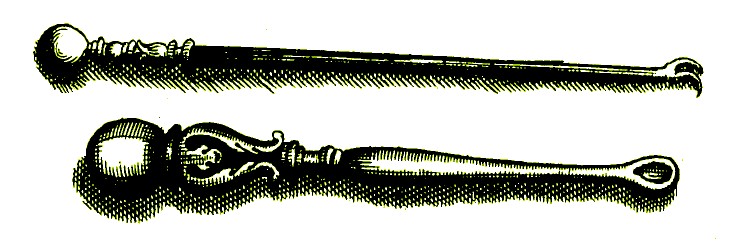 Bullet Hook and Scoop, From The Chyrurgeons Storehouse, Johannes Scultetus, p. 38 (1674) Bullet Hook and Scoop, From The Chyrurgeons Storehouse, Johannes Scultetus, p. 38 (1674) |
1 Elizabeth Bennion, Antique Medical Instruments, 1979, p. 73; 2,3 Johannes Scultetus, The Chyrurgeons Storehouse, 1674, p. 39

